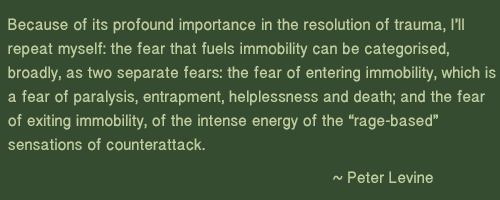Currently, a posttraumatic stress disorder (PTSD) diagnosis is the closest thing there is to
a trauma diagnosis. However, PTSD criteria do not cover the entire range of trauma-based
symptoms and conditions (Dansie et al., 2012; Hall, 2000). The reality is that many people
suffering with trauma do not qualify for a PTSD diagnosis, and are instead diagnosed with
different disorders based on the symptoms they display, not on their etiology (D’Andrea, Ford,
Stolbach, Spinazzola, & van der Kolk, 2012; Haven, 2009; Herman, 1992; McFarlane, 2010;
Sledjeski, Speisman, & Dierker, 2008; van der Kolk, 1994). Reducing or containing various
symptoms, without first locating and addressing their cause, often results in inaccurate and
multiple diagnoses. This prolongs unnecessary suffering, usually leads to retraumatisation, is
time consuming and wasteful of scarce resources. Therefore improved classification of disorders
according to etiology is very much warranted. Read on
Monday, April 27, 2015
Towards a comprehensive model of trauma
This article, Towards a comprehensive model of trauma is a synthesis of my MA thesis, hope you enjoy it. Here is an excerpt:
Friday, April 10, 2015
Normalising innate behaviours
All of us use expressions such as “I was scared stiff” or “I froze”. But how many of us know that the response that these expressions refer to is tonic immobility? (More commonly known as the freeze response). We’re all aware of the famous ‘fight or flight’ term, but few of us have heard of tonic immobility, a response to any threat that we perceive as dangerous, that can overwhelm our coping mechanisms. We can even find experiencing tonic immobility itself overwhelming because it can render us, involuntarily, physically immobile and unable to speak, which leaves us feeling helpless. And on top of that, we often judge ourselves harshly when we respond in a supposedly ‘weak’ or ‘passive’ way. We feel ashamed of not ‘fighting back’ and these appraisals can also overwhelm us and prevent us from resolving any trauma.
Tonic immobility is evolution’s gift to us in order to keep us alive. Sometimes, in the face of threat and danger, it is safer to remain immobile or ‘play dead’, rather than fight or run. Sometimes fleeing or fighting are not even viable options, especially when we’re very young. We don’t make the choice not to move or not to call out for help voluntarily, this innate behavior and instinct is hardwired in us in order to ensure our survival.
As Peter Levine writes in his book In an Unspoken Voice: How the Body Releases Trauma and Restores Goodness:
Tonic immobility is evolution’s gift to us in order to keep us alive. Sometimes, in the face of threat and danger, it is safer to remain immobile or ‘play dead’, rather than fight or run. Sometimes fleeing or fighting are not even viable options, especially when we’re very young. We don’t make the choice not to move or not to call out for help voluntarily, this innate behavior and instinct is hardwired in us in order to ensure our survival.
As Peter Levine writes in his book In an Unspoken Voice: How the Body Releases Trauma and Restores Goodness:
As traumatised individuals begin to reown their sense of agency and power, they gradually come to a place of self-forgiveness and self-acceptance. They achieve the compassionate realisation that both their immobility and their rage are a biologically driven, instinctual imperative and not something to be ashamed of as if it were a character defect. They own their rage as undifferentiated power and agency, a vital life-preserving force to be harnessed and used to benefit oneself. Because of its profound importance to the resolution of trauma, I’ll repeat myself: the fear that fuels immobility can be categorized, broadly, as two separate fears: the fear of entering immobility, which is the fear of paralysis, entrapment, helplessness and death; and the fear of exiting immobility, of the intense energy of the “rage-based” sensations of counterattack. Caught in this two-sided clamp (of entering and exiting), immobility repels its antidote implacably so that it seems impossible to break through it. However, when the skillful therapist assists clients in uncoupling the fear from immobility by restoring “self paced termination of immobility”, the rich reward is the client’s capability to move forward in time. This “forward experiencing” dispels fear, entrapment and helplessness by breaking the endless feedback loop of terror and paralysis.
Subscribe to:
Posts (Atom)

